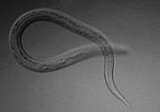
Necator americanus
Encyclopedia
Necator americanus is a species of Necator. It is a class within the phylum Nematodes and commonly known as New World hookworm. It is a parasitic nematode worm that lives in the small intestine of hosts such as humans, dogs and cats. It is responsible for Necatoriasis. Since Necator americanus and Ancylostoma duodenale
(also known as Old World hookworm) are the two most common human hookworms, they are usually discussed together as hookworm infection. They only differ in geographical distribution, structure of mouthparts and relative size.
It has been proposed as an alternative to Trichuris suis
in helminthic therapy
.
Cutaneous larvae migrans is a zoonosis
infection that occurs when humans become an accidental host. The definitive hosts for these species are cats and dogs. The cycle in the definitive host is similar to that in humans, the difference is when the filariform larvae burrow through human skin. Because the filariform can only reproduce and mature in its definitive host, it wanders throughout the epidermis layer where it can not penetrate deeply into the human skin. The trail of the filariform penetration is visible across the skin since it can only burrow through its outer layers.
Transmission of Necator americanus infection requires the deposition of egg-containing feces on shady, well-drained soil and is favored by warm, humid (tropical) conditions. Therefore, infections worldwide are usually reported in places where direct contact with contaminated soil occurs.
Ancylostoma duodenale
Ancylostoma duodenale is a species of the worm genus Ancylostoma. It is a parasitic nematode worm and commonly known as Old World hookworm. It lives in the small intestine of host such as humans, cats and dogs....
(also known as Old World hookworm) are the two most common human hookworms, they are usually discussed together as hookworm infection. They only differ in geographical distribution, structure of mouthparts and relative size.
It has been proposed as an alternative to Trichuris suis
Trichuris suis
Trichuris suis is a whipworm; the variations in thickness of the anterior and posterior segments give the parasite the characteristic “whip-like” appearance. Adult females measure 6 to 8 cm and adult males 3 to 4 cm. T. suis eggs are oval and yellow-brown with bipolar plugs.T...
in helminthic therapy
Helminthic therapy
Helminthic therapy, a type of immunotherapy, is the treatment of autoimmune diseases and immune disorders by means of deliberate infestation with a helminth or with the ova of a helminth. Helminths are parasitic worms such as hookworms and whipworms....
.
Morphology
This parasite has two dorsal and two ventral cutting plates around the anterior margin of the buccal capsule. They also have a pair of subdorsal and a pair of subventral teeth that are located close to the rear. Males are usually 7mm-9mm long, while females are about 9mm-11mm long. The typical life span of these parasites is three to five years. They can produce anywhere between 5000 to 10,000 eggs per day.Life cycle
This worm starts out as an unembryonated egg in the soil. After 24–48 hours under favorable conditions, the eggs become embryonated and hatch. This first juvenile stage 1 is known as rhabditiform. The rhabditiform larvae grow and molt in the soil transforming into a juvenile stage 2. The juvenile stage 2 molts once more until reaching the juvenile 3 stage which is also called filariform; this is also the infective form. The transformation from rhabditiform to the filariform usually take 5 to 10 days This larvae form is able to penetrate human skin, travel through the blood vessels and heart, reaching the lungs. Once here, they burrow through the pulmonary alveoli and travel up the trachea where they are swallowed and are destined for the small intestine. This is where they mature and reproduce into adults by attaching themselves to the intestinal wall causing an increase of blood loss by the host. The eggs end up on the soil after leaving the body through the feces. On average, most adult worms are eliminated in 1 to 2 years. N. americanus life cycle only differs slightly from A. duodenale. N. americanus has no development arrest in immune hosts and it is necessary for it to migrate through the lungs.Cutaneous larvae migrans is a zoonosis
Zoonosis
A zoonosis or zoonoseis any infectious disease that can be transmitted from non-human animals to humans or from humans to non-human animals . In a study of 1415 pathogens known to affect humans, 61% were zoonotic...
infection that occurs when humans become an accidental host. The definitive hosts for these species are cats and dogs. The cycle in the definitive host is similar to that in humans, the difference is when the filariform larvae burrow through human skin. Because the filariform can only reproduce and mature in its definitive host, it wanders throughout the epidermis layer where it can not penetrate deeply into the human skin. The trail of the filariform penetration is visible across the skin since it can only burrow through its outer layers.
Epidemiology
N.americanus was first discovered in Brazil and then was found in Texas. Later it was found in indigenous in Africa, China, southwest Pacific islands, India and Southeast Asia. This parasite is a tropical parasite and is the most common species in humans. Roughly 95% of hookworms found in the southern region of the United States are N.americanus. This parasite is found in humans, but can also be found in pigs and dogs.Transmission of Necator americanus infection requires the deposition of egg-containing feces on shady, well-drained soil and is favored by warm, humid (tropical) conditions. Therefore, infections worldwide are usually reported in places where direct contact with contaminated soil occurs.

